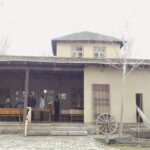The Meros Silk Paper Factory was one of the last stops on this November’s trip from Bishkek to Kazakhstan and Uzbekistan, organized by SRAS and The London School of Bishkek as part of the Central Asian Studies study abroad program. Just outside Samarkand, Uzbekistan, the factory was built little over a decade ago, but it employs a method that is more than 1000 years old. Central Asia acquired silk, along with the secrets of its manufacture, from Chinese merchants traveling along the Silk Road. The technique for making silk paper came to the region of Uzbekistan in the 8th century AD.
About 20 people work at the Meros Factory, producing around 100 sheets of paper a day. Silk paper, which was used for many Arabic manuscripts in the 9th and 10th centuries, is water-resistant and said to last for 2000 years (as opposed to the 100 year life-span of typical printing paper).

Silk paper is usually made by combining silk fibers with a binding agent. The silk paper at Meros is actually made from the bark of mulberry trees, whose long, soft fibers create a paper with very similar properties to that created with silk. The bark also has enough of its own natural binding agent that none need be added. Thus, the process at Meros involves no electricity, and no added colors, chemicals, or ingredients – the final product consists only of the bark’s fibers, and water. The process is slow, simple, and lovely to watch.
It begins with mulberry trees, whose thin branches are cut into pieces about two feet long. These are soaked in basins of water for a day, after which the bark is scraped off in long ribbons with a knife. The yellowish strips of bark are boiled in a large vat – the water turns a deep reddish-brown, the stewing bark looks something like thick, tangled noodles, and the steam has a sweet, woody smell. After several hours, the bark is much softer and pulls apart easily into strands.

The soft bark is then mashed using an impressive mill system: a thick tree trunk lies in a dammed stream right in front of the factory. The trunk rotates thanks to the water wheel on one end. Along the trunk, wooden spokes protrude and knock against four long wooden poles, angled up from the stream and through four windows in the factory wall. These poles pivot slightly when knocked. Vertical stakes are attached to the ends of the poles inside the building. The stakes move up and down when the poles pivot, mashing bark in small wooden basins beneath each stake. Workers mix the bark mashing beneath the stakes with wooden sticks.

Eventually, this process creates a thick, clay-like substance, which is mixed into a rectangular wooden basin of water. A screen is submerged into the water, lifted out, and flipped over – creating a wet sheet of silk paper. The sheets are stacked under a wooden platform beneath two heavy stones, and the paper lies under this weight for about a day to flatten. The sheets are then hung up to dry – for a few hours in the summer, or almost a full day in winter. Once dry, the thin, tan sheets are nearly completed. All that’s left is to smooth the paper’s rough surface. This is done by hand, with a flat, leveled and smoothed side of a stone, shell, or ram’s horn. The final product is soft – even silky – to the touch.

The factory is small, and a tour of the premises and process (in Russian) lasts about fifteen minutes. There is also a lovely gift shop, selling decorated silk paper postcards (500 sum/$2), silk paper notebooks (25,000-40,000 sum/$10-$17), and ornaments, figures, paintings and calligraphy all made with, or on, silk paper. Even this paper, as sold in the shop and many steps and days removed from the boiling vat outside, retains a faint woody, nutty smell.
After our tour and visit to the gift shop, our group was treated to hot green tea on the porch of the factory. It’s a quiet, peaceful spot, with streams running through the trees in front and behind the building, crossed by wooden bridges. It is certainly worth a visit by any travelers who happen to find themselves near Samarkand with some time on their hands. The small wooden factory is not as grand or breathtaking as the turquoise-tiled madrasas, mosques, and mausoleums in the city, but it is just as unique to the area and, in some ways, just as ancient.
Meros Silk Paper Factory/Бумажная Фабрика «Мерос»
Koni Ghil/Кони Гил
Tour cost: 3000 sum/$1.25













